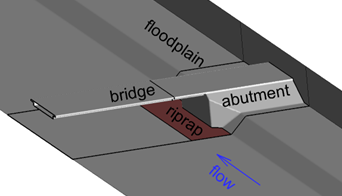Dr. George Constantinescu, Professor in the Department of Civil and Environmental Engineering at the University of Iowa, has completed Phase V of his project as part of the Mid-America Transportation Center (MATC). Titled “Development of New Design Guidelines for Protection against Erosion at Bridge Abutments”, the project investigates erosion at bridge abutments caused by severe flooding in the United States Midwest. The bridges in the study were designed to specifications in the Federal Highway Administration’s Hydraulic Engineering Circulars (HECs) guidelines for bridge design. Despite using these guidelines, there is room for improvement to increase safety, especially in river-crossing structures that need to remain operational during floods and other extreme weather events.
Bridge abutments are the substructure at the end of a bridge span that supports its superstructure. It is important in retaining the embankment, and when the bridge is above a river or stream, the abutment can be highly effected by water erosion, especially during severe floods. Placing riprap stone (layer of large, angular stone, cobbles, or boulders) around the base of each abutment is the most common way to protect against erosion.
This study looked at the two most common types of abutments (spill-through and wing-wall) and used fully 3-D, non-hydrostatic RANS numerical simulations to determine the conditions for riprap shear failure in cases where a riprap apron was placed close to an abutment. This modeling aimed to estimate the position and spatial extent of the region that needs to be protected at bridge sites. It also set out to determine the minimum size of riprap stone needed to resist entrainment due to overflow and protect from erosion by considering flow depth and diameter of riprap and level of submersion.
This research specifically takes into account bank curvature and important geometrical parameters such as floodplain width and relative abutment length, which affects the flow and its capacity to entrain sediment near bridge abutments. The main finding in year 4 of the project was a new, two-parameter riprap sizing formula for protection of spill-through abutments against erosion to be sed in both straight and curved compound channels. The main outcome of year 5 was the development of the 3-D RANS numerical model to predict bed shear stress distributions over the apron region.
Future work will aim to generate more data for abutments where the flow at the bridge site is pressurized to propose new design equations. This project is under the MATC Region VII University Transportation Center grant from the US Department of Transportation.

